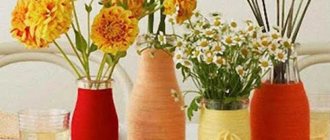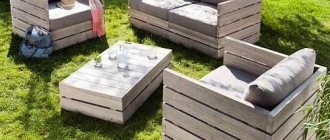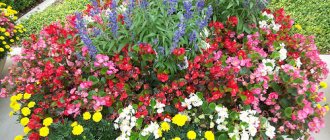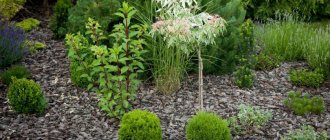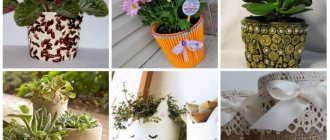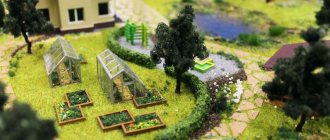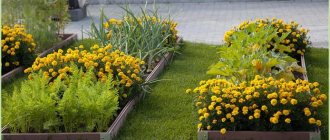Vases, or flower pots of different sizes, are classified as small architectural forms. The materials from which they are made can be very different: ceramics, gypsum, wood, concrete.
Elite options are also available for sale - marble and natural stone. Forms with planted plants are installed directly in the open air: on terraces, in courtyards. Outdoor flowerpots differ from indoor flowerpots in size and location: they are not for indoor spaces. Such flowerpots on the territory of a theater, restaurant, bank, near an administrative building, as well as in a garden and park area will not only decorate the street, but will also present the plants in a favorable light.
using large flowerpots to decorate an alley
It should be noted that garden flowerpots should be one with the dacha area, so you can safely choose a specimen with strict geometric shapes, with unusual, extravagant and even flashy notes . Let's say right away that small flowerpots are not suitable for large areas, they look ridiculous; and vice versa: if you want to use large flowerpots in a small area, then this should be done in exceptional cases and very carefully.
using outdoor flowerpots you can decorate a recreation area
Now about fashion in colors. Flowerpot landscape fashion also dictates its own rules. Here it is worth sticking to the basics: the “colorfulness” of the pot should be no brighter than the plant itself planted in it; otherwise, the plant will be “lost” against its background. In general, it is better to take plain garden flowerpots: then these will highlight the plant and emphasize the style. The main and win-win shades are white, terracotta, brown, gray.
using flowerpots to decorate entrance doors
Advantages of outdoor flowerpots
The advantages of using flowerpots are:
- Mobility. If the plant is planted in an outdoor pot, then there is a possibility that it can be moved around the garden. If you don’t like the plant, you can always replant or replant it, that is, a new flower arrangement can appear at any time. Under unfavorable natural conditions, a garden flowerpot can always be easily moved under a roof or canopy.
in the warm season, you can decorate your site with indoor plants
- Decorative. Having plants is always a winner. Even a small courtyard will look different if you place flowerpots on its territory.
Glowing flowerpots act as lanterns in the garden at night
- Practicality. Not only flower growers appreciated the declared type of flowerpots for the garden. With the help of these decorative vases you can separate the area intended for relaxation from the utility area. In addition, a separate mobile vase will help create conditions for some too “capricious” plant (for example, if the soil is not suitable for it).
with the help of flowerpots you can create original compositions on the veranda or gazebo
- The economic side of the issue. The cost of outdoor flowerpots (especially if the products are made from inexpensive materials) is low. You can make flowerpots with your own hands. Those who have already tried this option claim that such a product can safely claim to be an object of well-deserved pride.
Features of homemade flower pots and flowerpots
Currently, small decorative flower beds that harmoniously fit into the design of the natural territorial complex are very popular. Growing live plants in outdoor flowerpots is quite simple, because you can always independently select the appropriate soil composition, replace it, and also create optimal conditions, depending on your needs, placing flowerpots in well-lit or, conversely, shaded places.
Thanks to modern techniques, technologies and materials, it is possible to design simple and complex, stationary and portable, hanging outdoor pots and flowerpots, as well as on struts.
It is necessary to select the base material, shape, texture and color of such products taking into account the style of landscape design of the land where the decorative element will be placed, and also do not forget about the principles of combination.
A good accent for a dacha or country house will be stationary decorative flowerpots arranged along the paths and paths leading to the house. Such decorations will also perfectly complement a terrace with a porch.
Using hanging flowerpots you can decorate gazebos, garden arches, and walls of architectural buildings. Moreover, a room surrounded by plants planted in open ground and in flowerpots will become many times brighter and more beautiful. Stationary models with different decorative elements, assembled into original compositions, will be able to decorate the landscape for a long time. In turn, portable flowerpots or so-called mobile flower beds with flowering plants can be moved to different places, and if necessary, they are quite easy to replace.
When choosing the size of the flowerpot, you need to take into account the scale of the site.
In a large area, small pots will get lost, and in narrow alleys, large containers will be inappropriate. They will disrupt the harmony of space and make the design ridiculous. A flowerpot of the ideal size will fit organically into the landscape and will stand out moderately (place in plain sight without drawing much attention to itself). It will become a suitable frame for the plants planted in it. Flowerpots are often installed along the edges of stairs, alleys and garden paths. They can also be placed in any corner of the site, including in the center of the land.
As for colors, today the use of products in white, plain beige, brown and terracotta shades is in fashion; delicate pastel colors are also relevant. They perfectly set off the greenery and all flowering plants. Vases of too bright colors draw attention to themselves, and the flower arrangement goes unnoticed.
This is the wrong approach to landscaping, so experts do not recommend decorating your lands in this way.
Advantages and disadvantages
Flowerpots as landscape decoration, which require making with your own hands, have positive and negative sides.
The advantages include:
- Transportability. Thanks to their easy movement around the territory, you can create new compositions, and during bad weather or in winter, transfer plants to the attic or veranda.
- The ability to decorate a yard where the ground is covered with concrete or tiles and planting plants in the ground is impossible.
- Fencing function. With the help of outdoor containers, you can divide the area into zones and create a cozy corner.
- The ability to create favorable conditions in each flowerpot for an individual plant: special soil, fertilizer, watering.
- Low cost. Compared to many other garden décor items, containers save money. Handmade products allow you to do this twice as much.
- Space saving. You can place not only flower beds in containers, but also cultivated plants, and use them instead of beds for growing cucumbers, tomatoes, herbs, and berries. This is especially true for small areas in order to save space.
Flowerpots for the street have practically no disadvantages, however, depending on the material, several of them can be distinguished:
- Fragility. Applies to products made of plastic and wood.
- Plastic flowerpots are harmful to health as they can release hazardous substances into the air.
- Ceramic products are very fragile.
- Plants in ceramic and metal containers require frequent watering due to the soil drying out too quickly.
- Heavy weight. Products made of concrete and stone have this disadvantage.
Conclusion
In general, it is quite possible to make not only an “eternal”, but also an exclusive flowerpot yourself. Concrete, a little ingenuity and imagination and years of admiring not only the content, but also the form.
In recent years, the loft style has become increasingly popular, and with it concrete, not only in gardening, but also in the interior. Concrete makes excellent functional and very original furniture. No less interesting is a material such as tadelakt - it is not only the oldest type of plaster, but also an excellent material for covering concrete sinks. The video shows the first experience of landscape design.
Subscribe to our Telegram channel Exclusive posts every week
Selecting materials
There are many interesting and beautiful models of flowerpots for the garden on the modern market, but any person wants to bring some individuality and zest to their home or the space surrounding it. There are a lot of options on how to make decorative pots with your own hands. All you need to do is choose a material that will successfully complement the already formed microclimate on the land plot, and begin designing flowerpots and flowerpots for the street.
To manufacture this type of product, both natural and artificial materials can be used. It can be stone, metal, clay, plastic, glass, foam, concrete.
The raw materials used for making outdoor flowerpots affect their characteristics:
Clay models
This material has high plasticity, thanks to which flowerpots of various shapes and textures can be made. Natural material is highly porous. As a result, the root system of plants in such a flowerpot is placed freely, and the plant breathes well through the soil. If the product is coated with glaze, it will lose its throughput. Clay pots are attractive and versatile, suitable for any interior.
Stone products
Three-dimensional ornaments and patterns can be carved into flowerpots made from this material. The process of making them is time-consuming, labor-intensive, and requires a lot of physical strength and endurance. This is why stone flowerpots on the market are among the most expensive. The advantages of such flower tanks include high decorative properties, strength and durability, and ease of maintenance. In addition, the stone is waterproof, which means that it retains moisture in the soil for a long time.
Wooden flowerpots
Made from natural wood. Artificial branches are also used, but this combination does not always result in an attractive look, so a combination of natural and artificial raw materials is rarely used. Natural material is impregnated with an antiseptic so that wooden flowerpots last as long as possible and do not deteriorate (do not rot, and they are not eaten by living creatures), and are varnished or painted if desired.
Wooden pots retain moisture well, so they are suitable for planting moisture-loving plants.
Metal
Most are made of cast iron, brass, steel, and zinc. They are containers of smooth geometric shapes. All of the above materials rot when exposed to moisture, so compositions made from them are painted. We also must not forget that metal flowerpots quickly heat up in the sun, so they need to be watered from time to time on particularly hot days, otherwise the roots of the plants planted in them will “burn.”
Concrete flowerpots
The characteristics of this raw material are almost the same as those of stone, but the cost of concrete products is much lower. In hot summer conditions, outdoor concrete flowerpots retain moisture in the soil, so plants feel comfortable in such containers. The root system of flowers in a concrete sarcophagus does not overheat or overcool. This occurs due to the low thermal conductivity of concrete.
Flowerpots made from it look solid; due to their massiveness, they are suitable for large areas.
Plastic
Flowerpots made from artificial raw materials can come in a variety of shapes and colors. Frost-resistant perennial plants that do not require replanting in winter can be planted in plastic pots (plastic pipes).
In addition to the materials presented, hypertufa, glass (glass bottles) and other available means can be used. Many people are attracted to flowerpots made of tires, polystyrene foam, and plaster. Cones, wooden and plastic parts are suitable as decoration.
Thus, with your own hands you can create original and beautiful products that will decorate the land, harmoniously combining with the chosen style of landscape design, buildings erected on the land and green spaces.
Car tires
In small gardens, near the entrances of residential buildings, flowerpots made of tires are often found. Elastic rubber allows you to give them a fancy shape. The creation process does not require special effort, skills or costs. This is the reason for their popularity.
So how to make these interesting flower beds that will decorate your garden? Studless summer tires are best. The wheel rim inside will serve as a stand.
You will need:
- car tire with a wheel rim inside;
- Sander;
- shoe knife or jigsaw;
- a piece of chalk;
- oil paint, enamel paint or nitro paint; car spray paint is also suitable;
- soap solution;
- paint brush;
- degreasing solution;
- primer.
Manufacturing process:
- After cleaning the tire from dirt, place it on a flat surface. Mark the cutting line with chalk. Its shape can be arbitrary, but all protrusions must be symmetrical and of the same size, otherwise the edges of the flowerpot will look sloppy.
- Soak a knife or jigsaw in soapy water. Cut out the top sidewall of the tire.
Types of outdoor flowerpots
Like indoor pots, outdoor flowerpots can come in all shapes and configurations. Large containers are placed instead of fencing, for zoning the site or just for beauty. This is the simplest way to create different conditions and soil for different flowers.
Floor-standing
Floor planters are easy to transport and can be placed around the yard on tile or concrete. This is a good alternative to raised beds if the soil on the site is poor. To care for seedlings, you won’t have to constantly bend over, which is very convenient if you have back problems.
Hanging
Hanging flowerpots are very beautiful and romantic, creating an atmosphere of airiness and lightness. They pair beautifully with hanging garden lights or decorative garlands. This is the best choice for climbing, climbing and hanging plants.
How to make flowerpots with your own hands
You will need leftover building materials or any small items at hand. Homemade containers are unique, so they look fresh and interesting. Don't forget about rot protection, waterproofing to maintain soil moisture and good drainage for ventilation.
Outdoor flowerpots made of plywood and boards
The easiest way to make beautiful flowerpots is from ordinary boards or plywood. Don’t push them too tightly together – this will give you excellent natural ventilation. For impregnation you will need oil or oil-based paint, which will protect against rotting. To prevent the flowerpot from becoming moldy or overgrown with fungus, you need small decorative legs.
Outdoor flowerpots made of logs
Old stumps and logs, which periodically need to be uprooted from any area, will make spectacular flowerpots. Cut the trunk, remove the inner part of the wood with a drill and chisel, and leave the bark intact. If the tree is not rotten, then the process is quite labor-intensive, but very simple.
Outdoor flowerpots from a barrel
You can simply cut an old barrel in half, drill drainage holes and put it on legs. And cut it however you like: lengthwise, across, even diagonally - the main thing is that the structure holds. If you need a deep, roomy flowerpot, remove some sections from the entire flowerpot.
Flowerpots made from wicker baskets
A wicker basket is essentially a ready-made flowerpot that doesn’t even need additional ventilation. Choose a tighter weave so that the soil does not fall out, wash out or blow out of the cracks. Like wood, the basket should be painted with a fungal protective agent.
Outdoor flowerpots from a bucket
A bucket is a very simple version of a flowerpot, because you only need to drill drainage holes at the bottom. Their optimal diameter is 1-1.5 cm, and they should be located evenly over the entire plane. The outside of the flowerpot can be painted with moisture-resistant acrylic, covered with wooden planks, or decorated to your taste.
Instead of a bucket, they also use a basin, plastic bottles or a large five-liter eggplant.
To ensure stability of the structure, add some pebbles to the bottom, and it is recommended to make the largest plastic containers stationary. To do this, they are put on metal pins dug into the ground.
Outdoor flowerpots made of concrete
Concrete can be cast into any shape, so it’s easy to make minimalist flowerpots from it yourself. You will need cement grade M400 or higher and clean river sand. You can take so-called artistic concrete with the addition of acrylic, polymer additives or small particles for an interesting texture.
Make the main shape from ordinary packaging cardboard, gluing the construction joints with tape. Line the bottom with plastic wrap so that the cardboard is easier to remove and there are no uneven spots left. Then pour the cement inside and push the middle with a bowl, bucket, basin or any other container. Sand the finished flowerpot with a metal brush, rinse with water and dry.
Flowerpots made from building blocks
If after building a house there are several concrete blocks with large cells left, these are ready-made flowerpots. Entire walls or partitions, chaotically assembled from such blocks filled with soil, look interesting. Experiment with placement, angles, order and sizes.
Outdoor flowerpots made of stone
From stone and mortar you can assemble stationary outdoor flowerpots that resemble a mosaic. Travertine, onyx or sandstone are better suited for this. You can cut ready-made slabs or use large natural stone. The principle is the same as when creating conventional brickwork.
Outdoor flowerpots made of metal mesh
A structure made of a metal mesh filled with stones is called a gabion. Now they are very popular in landscape design, and you can make them yourself. You just need to install the outer and inner contours of the mesh and fill the void with stones.
Flowerpots made from car tires
Old unnecessary tires have long been used for all kinds of crafts in the country. To make a flowerpot out of them, draw an outline, cut out the part with a rubber knife and turn the tire inside out. To keep the shape better, make cuts every 10 cm.
Silicate blocks
You can make your own flowerpots from hollow building blocks. They look unusual and fit well into a high-tech garden. When creating them, carefully consider the shape of the structure. It must be sustainable and fit well with the external environment. A sketch prepared in advance will greatly facilitate production.
You will need:
- blocks;
- glue;
- plastic or wooden base.
Manufacturing process:
- Cut the plastic or wood base to fit the bottom of the block. Attach it to the bottom with glue. Do this with all modules that are intended for the tier bordering the ground.
- According to a pre-prepared sketch, connect the blocks to each other with glue, starting from the bottom layer.
- Fill the empty containers with a drainage layer, soil, and plant the plants.
It’s easy to make cute flowerpots with your own hands from plaster. This material will allow plant roots to receive oxygen, but it does not retain moisture well. Therefore, it is better to choose a shady place for the gypsum module. It will not be difficult for you to vary the accents in the garden by rearranging the flower beds, because they are very light and mobile.
You will need:
- cardboard box in the shape of a cube or parallelepiped;
- sandpaper;
- plaster or medical bandage;
- gypsum powder;
- brush;
- white acrylic paint for the base;
- white enamel.
Manufacturing process:
- Measure the height of the flowerpot from the bottom of the box, adding 1.5 cm. Cut off the excess part.
- If the surface of the mold is too smooth, it is recommended to sand it for better adhesion to the plaster.
- Cut the plaster bandage into strips. Or make a solution of gypsum with water in a separate container. Its consistency should be like thick sour cream. And dip a medical bandage into the solution.
- Remove excess by passing the bandage between the index and middle fingers. Wrap the sides of the mold, starting from the top.
- Dry the workpiece. Remove irregularities with sandpaper. Pull out the form.
- Cover the surface with white acrylic paint. After it dries, apply white enamel.
- Apply a final coat of paint or varnish over the enamel.
- To decorate a plaster flowerpot, use pebbles, shells, buttons, beads, rope, pasta, etc.
This product can be used as a flowerpot for a plastic pot with plants. In order for flowers to be planted directly into a flowerpot, a drainage hole must be made in its bottom.
Finish options
For large outdoor flowerpots, you can choose original decor that will be the finishing touch to their design.
The easiest way is to paint the product with paint. You can use one shade for all the flower girls made, or you can create a multi-colored composition of all the colors of the rainbow. The main thing is that the planted plants harmonize in color with the painted container.
For areas with houses in ancient styles, artificially aged flower beds are suitable. To do this, they are coated with the chosen paint, and a layer of craquelure is applied on top.
In order for the paint to last for a long time, the surface must first be coated with a primer.
Another way to design an outdoor planter is to decorate it with various available materials. The decor can be created from cones, branches, small stones or pebbles, broken tiles, mirrors or colored glass, creating a mosaic effect. To do this, you only need special glue.
If it spills or stains the surface, it must be removed immediately, otherwise, after it has hardened, it will be impossible to do this.
After this, the pot should be allowed to dry. If tiles, glass or stones are used as decoration, the surface can be additionally treated with grout to complete the work. In addition to natural stones, you can use artificial ones, which will be perfectly sized and look more aesthetically pleasing than natural ones.
Flowerbed care
An abandoned flower garden with peeling paint, faded and darkened edges will spoil the overall impression. In order to maintain the well-groomed, dignified appearance of your homemade creation for a long time, you need to take care of it responsibly.
Caring for wooden products should be systematic
If possible, during the period when the flowerbed is empty, the soil should be removed and the frame should be set to dry, followed by cleaning (if the structure is not used for perennial plants). Then apply a second layer of preservative impregnation and paint coating. Coating products must be chosen strictly “for external use”, with a corresponding mark on the label. It makes sense to additionally treat flower beds located near barbecue areas and grill areas, where open fires are often lit, with biopyrenes.
How to register a summer cottage?
When choosing containers for flowers as decoration for your site, you should first of all evaluate their safety for people. For example, commonly used tires from car tires are not the safest option. They can release toxic substances into the air and be dangerous, especially if there are small children in the family.
In addition to safety, the flowerpot must meet the requirements for appearance: match the size and style of the site.
Its size should fit harmoniously into the space. In addition, if the house and the entire site are decorated in a certain style, the flowerpots must correspond to it.
Not all plants are suitable for planting in outdoor pots. To decorate an area with flower arrangements, it is worth taking into account the characteristics of their root system, watering and need for sunlight.
The following plants are suitable for planting in flower beds:
- Petunia. These are easy to care for flowers of various colors that bloom all summer.
- Pansies. Their flowering continues for a long time. They are unpretentious, come in a variety of colors and varieties, and grow short but fluffy.
- Ageratum. It has a long flowering period and is unpretentious in watering.
- Fuchsia. Thanks to its cascading appearance, it creates the impression of being in a blooming, fragrant garden.
- Verbena. Suitable for planting in containers, has a modest root system, and can be combined with other plant varieties.
Flowerpots from a stump
A stump, if it is whole, not rotten and has not been damaged by termites, can be transformed into a flowerpot in an original way. For work you will need a drill and a chisel. At the first stage of creating a unique tank, you need to drill the surface of the stump in different places, making as many holes as possible, then use a chisel to remove all unnecessary wood from the stump to make a deep bowl. The finished hole is filled with earth and flowers are planted there.
A cut tree with plants planted in it looks very creative. You need to make a hole in it, just like in a stump, and then place a pot of planted herbs.
Preparatory work
Before you start making a flower bed, you first need to think through a drawing of the future structure. Based on the calculations obtained, purchase boards and tools, stock up on the required amount of fasteners and consumables, including screws, plugs, angles, bushings, clamps for tightly joining the bars. To firmly connect low fences, you will need metal pins; they can also be useful for reinforcing the foundation.
Approximate drawing of a multi-tiered pyramid structure consisting of three square buildings
It is also worth purchasing geotextiles or a drainage membrane in advance to cover the bottom of a homemade flower bed.
It is advisable to sand the entire surface of the boards and clean off rough edges. Then they need to be carefully treated with special solutions with the effect of staining and priming. Deep impregnation of the frame with combined antiseptics (colorless or containing coloring pigments) allows you to prevent the occurrence of cracks and deformation from inevitable swelling and drying out, and reduce the likelihood of putrefactive processes and damage by wood-boring insects.
The bark on a log, stump, or snag can be left intact only if the base has no obvious damage and no traces of parasites.
Brushing and sanding with coarse sandpaper will help to add texture and emphasize the texture of sanded workpieces.
Whether to leave the natural coloring of the fences, or to choose a color scheme that contrasts with the planted plants, to match the surrounding environment, in accordance with the overall style - the choice depends on the creativity and preferences of the owner. However, it’s never too late to repaint a flower garden if the concept suddenly changes. If desired, it is easy to complement it with a thematic or ornamental design, which is applied with a burning device (pyrograph) and looks very stylish on the sides.
Professionals recommend coating all internal structural elements with birch tar or bitumen-rubber mastic made from environmentally friendly ingredients (rubber, beeswax), intended specifically for treating surfaces buried in the ground. Such waterproofing, due to the formation of a waterproof film, will not only protect the natural material from exposure to dampness and fungal spores, but will also extend its service life.
To prevent direct contact of soil and roots with wood, it would be reasonable to place an EM-polyethylene liner in the soil cavity, which suppresses various groups of putrefactive bacteria and, in general (as the manufacturer indicates), has a positive effect on plant development.
When constructing large structures, you should take care of the necessary irrigation in advance. Watering is usually organized using a plastic perforated pipe (or several pipes) embedded in the center of the elevation.
Concrete flowerpots step by step
Concrete flowerpots are easy to use and differ little from stone products.
To create such a street piece with your own hands, you need:
- cement-sand mixture;
- two containers of the same shape (different in size): the larger one will become the mold for the product, the second will be needed to form the walls of the flowerpot;
- finishing paint;
- sunflower oil;
- plastic tube.
The sequence of actions is as follows:
- First you need to make a cement mortar. A high-quality mixture consists of cement and sand in a ratio of 1: 3, water is added to it, and, if desired, dye.
- All surfaces that will come into contact with the solution must be wiped with vegetable oil or another oil solution.
- You need to pour a layer of cement mortar no more than 2 cm thick into a large container, then insert pieces of plastic pipe (5 cm each) into it, which will form drainage holes.
- Place the smaller container in the cavity of the larger one so that the drainage tubes are completely hidden. The gap must be filled with cement mortar.
- After the mixture has hardened, you need to slowly remove the smaller mold from the larger one.
- Then the cement form must be sprayed with water, the structure must be wrapped in film and allowed to dry completely (usually this process takes a week).
- Afterwards, you need to carefully knock the product out of the mold. The work is finished. You can fill the flowerpot with soil and plant plants.
Tools
To work with wood and metal you will need the following devices and tools:
- Level;
- Roulette;
- Screwdriver;
- File;
- Jigsaw;
- Screwdriver;
- Hammer;
- Welding machine (for metal elements);
- Construction pencil.
When choosing fastenings, proceed from the position that the more weight the structure must withstand, the better and more powerful the fastening you select.
Master class from a plastic barrel and wood
You can make a flowerpot from a plastic barrel. Simple containers can be used to create interesting flower arrangements. Plastic barrels for food use and some wood elements are suitable for this.
Inside these containers you can place a lemon tree, avocado or fig tree. Plants like this will make a wonderful backyard decor.
- To make it you will need a plastic barrel. It needs to be cut.
- The top can be cut off using a thin blade and saw. First, draw a cut line with a marker.
- Then the edges of the cut need to be processed to remove burrs. A special tool is used for this.
- Then you need to drill holes for drainage. There should be a lot of them. This will allow the liquid to drain from the container with the plants.
- Then you need to prepare boards of the same size.
- The boards should be run through a planer and cleaned a little. Then use a table saw to cut them into even pieces.
- Then the bars are attached to the barrel. The boards should be very close so that there are no gaps. The barrel must be completely covered with boards.
- It is also worth installing a wooden sheet at the bottom of the barrel.
- The planks can also be attached at a slight angle to each other. This will add originality to the product. The edge of one board is laid on top of the previous one.
- For better fastening of the boards on the reverse side, they can be fixed using a construction stapler.
- The boards are used to make a frame for the top of the barrel. For this, short sections of wood are used. They need to be cut at an angle of 22.5 degrees, which will make an octagon.
- Interesting decor can be made from small boards that are laid out side by side in a line. Glue is used for fastening.
- Additionally, two holes are made for pouring out liquid. You can use old fabric to cover the holes.
- Small pebbles are placed at the bottom of the barrels for drainage.
- The pots are filled with soil mixture. Most of it is compost. Then the plants are planted. Mulch is laid on top to protect the soil from drying out. To prevent wood rotting, it is recommended to treat the surface with varnish. This will increase the life of the product.
Wicker and ceramic containers
Flowers in a basket always look very attractive. The only drawback of such a container is that the soil will spill out of it. Therefore, if you want to plant flowers in such a flowerpot, you need to make the inner layer of solid material. You can use plain fabric or polyethylene.
Ceramic flowerpots are classics of the genre. Products made from baked clay perfectly preserve the soil microclimate. Plants feel good in them, bloom and develop.
Glowing outdoor flower vases
A new feature in country house design is illuminated objects. Garden figures are illuminated with LEDs, which consume little energy. Even small solar panels can serve as a power source for them, which accumulate enough charge during the day to operate throughout the night.
Manufacturers offer for sale outdoor flowerpots with lighting in the shape of stumps or geometric objects.
